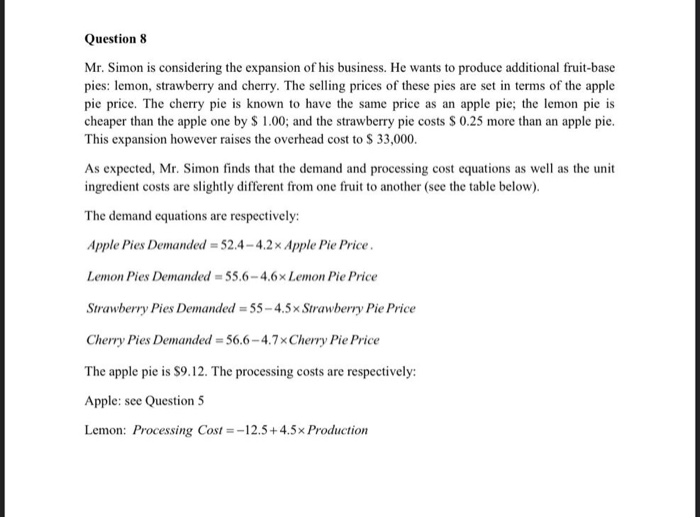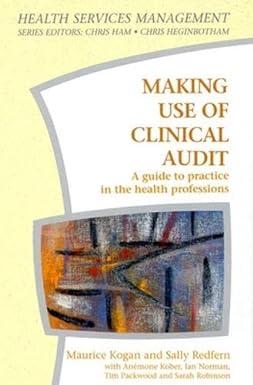Answered step by step
Verified Expert Solution
Question
1 Approved Answer
just do it Question 8 Mr. Simon is considering the expansion of his business. He wants to produce additional fruit-base pies: lemon, strawberry and cherry.


just do it
Question 8 Mr. Simon is considering the expansion of his business. He wants to produce additional fruit-base pies: lemon, strawberry and cherry. The selling prices of these pies are set in terms of the apple pie price. The cherry pie is known to have the same price as an apple pie; the lemon pie is cheaper than the apple one by $ 1.00; and the strawberry pie costs $ 0.25 more than an apple pie. This expansion however raises the overhead cost to $ 33,000. As expected, Mr. Simon finds that the demand and processing cost equations as well as the unit ingredient costs are slightly different from one fruit to another (see the table below). The demand equations are respectively: Apple Pies Demanded = 52.4 - 4.2 x Apple Pie Price. Lemon Pies Demanded = 55.6-4.6x Lemon Pie Price Strawberry Pies Demanded = 55 -4.5x Strawberry Pie Price Cherry Pies Demanded = 56.6-4.7xCherry Pie Price The apple pie is $9.12. The processing costs are respectively: Apple: see Question 5 Lemon: Processing Cost =-12.5 +4.5x Production Strawberry: Processing Cost = -12.4+3.6x Production Cherry: Processing Cost =-12.6+3.26x Production. In addition, the ingredients costs are provided in the table below. Apple Lemon Strawberry Cherry Total Unit cost fruit filling (s per pie) 3,48 2,2 3,9 3,1 Unit cost, dough 0,3 0,28 0,35 0,33 Fixed cost (000's) 33 a. Compute the usual financial outcomes. In particular show the contributions of each pie type and deduce the profit b. Draw a stacked column plot of the revenue, the contribution, the ingredient cost and the processing cost with the fruits on the horizontal axis. Note: Create Sheet_98 containing all calculations as well as the stacked column plot. Question 8 Mr. Simon is considering the expansion of his business. He wants to produce additional fruit-base pies: lemon, strawberry and cherry. The selling prices of these pies are set in terms of the apple pie price. The cherry pie is known to have the same price as an apple pie; the lemon pie is cheaper than the apple one by $ 1.00; and the strawberry pie costs $ 0.25 more than an apple pie. This expansion however raises the overhead cost to $ 33,000. As expected, Mr. Simon finds that the demand and processing cost equations as well as the unit ingredient costs are slightly different from one fruit to another (see the table below). The demand equations are respectively: Apple Pies Demanded = 52.4 - 4.2 x Apple Pie Price. Lemon Pies Demanded = 55.6-4.6x Lemon Pie Price Strawberry Pies Demanded = 55 -4.5x Strawberry Pie Price Cherry Pies Demanded = 56.6-4.7xCherry Pie Price The apple pie is $9.12. The processing costs are respectively: Apple: see Question 5 Lemon: Processing Cost =-12.5 +4.5x Production Strawberry: Processing Cost = -12.4+3.6x Production Cherry: Processing Cost =-12.6+3.26x Production. In addition, the ingredients costs are provided in the table below. Apple Lemon Strawberry Cherry Total Unit cost fruit filling (s per pie) 3,48 2,2 3,9 3,1 Unit cost, dough 0,3 0,28 0,35 0,33 Fixed cost (000's) 33 a. Compute the usual financial outcomes. In particular show the contributions of each pie type and deduce the profit b. Draw a stacked column plot of the revenue, the contribution, the ingredient cost and the processing cost with the fruits on the horizontal axis. Note: Create Sheet_98 containing all calculations as well as the stacked column plot Step by Step Solution
There are 3 Steps involved in it
Step: 1

Get Instant Access to Expert-Tailored Solutions
See step-by-step solutions with expert insights and AI powered tools for academic success
Step: 2

Step: 3

Ace Your Homework with AI
Get the answers you need in no time with our AI-driven, step-by-step assistance
Get Started


